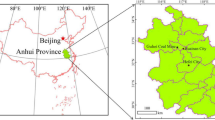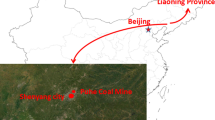Abstract
In order to choose the appropriate time for the dynamic reinforcement, the time effect of stress field evolution of the surrounding rock was first analyzed in this study. Then the deep soft rock roadway in Xinhu Coal Mine, China was taken as a typical example with regard to how the rheology-affected stress field of the surrounding rock evolved. The calculation algorithm of stress field evolution was given together with the corresponding program developed. Calculation results showed that the peak point of the surrounding rock in the early phase moved faster, where the turn appeared on the 60th day when the peak point lied 6.96 m away from the center of the roadway. Then the peak point moved at a slower pace, and finally, on the 124.8th day, the stress peak point was basically stabilized 7.21 m away from the center. In this way, the appropriate dynamically-reinforced supporting time of the No. 2 North rail-crosscut in Xinhu Mine was determined as 60 days after the primary support. In addition, a dynamic reinforcement technical plan was developed. The primary supporting system was bolt + W-shaped strip + diamond mesh + shallow hole grouting bolt + cable + shotcrete, and the reinforcement support system was bolt + M4 strip + diamond mesh + grouting cable. In-situ observation showed that both the maximum deformation and its maximum velocity in the roof and both walls of the roadway were small. The results indicated that both the reinforced supporting time and the parameters are appropriate.











Similar content being viewed by others
References
Bai JB, Wang XY, Yao Z (2007) Study of coupling support in soft rock roadway under high stress. J China Univ Min Technol 36(4):421–425 (in Chinese)
Chen YP, Zhang SH (2003) Research on the best secondary support time of the soft rock roadway. Ground Pressure and Strata Control 2:56–58 (in Chinese)
Dong FT (1991) Support theory based on the broken rock zone in surround rock. In: Proceedings of the 2nd international symposium on mining technology and science, pp 1130–1137
Gao SM, Chen JP, Zuo CQ et al (2016) Structure optimization for the support system in soft rock tunnel based on numerical analysis and field monitoring. Geotech Geol Eng 34:1089–1099
Guo JX, Gao YT (2009) Analysis of protection time of tunnel based on displacement theoryof shotcrete and bolt support for weak surrounding rock. J Univ Sci Technol Liaoning 32(5):456–459 (in Chinese)
Han L, Zuo YY, Guo Z et al (2017) Mechanical properties and deformation and failure characteristics of surrounding rocks of tunnels excavated in soft rocks. Geotech Geol Eng 35:2789–2801
He MC (2014) Latest progress of soft rock mechanics and engineering in China. J Rock Mech Geotech Eng 6:165–179
He MC, Sun XM (2004) China coal mining soft rock roadway engineering support designing and construction handbook. China Science Publishing & Media Ltd., Beijing (in Chinese)
He MC, Chen X, Liang GP, Qian HS, et al (2007) An introduction to version 1.0 of software on large deformation analysis for softrock engineering at great depth. In: 11th ISRM congress, Lisbon, Eds. Sousa,Olalla and Grossmann, pp 169–173
Hermann K (1971) Auf der Grundlage geomechanischer Erkennntnisse. Springer, Zweite neubearbeitete Auflage
HSE (1996) Safety of new austrian tunnelling method (NATM) tunnels. Health & Safety Executive, Bootle
Lu S (1991) Classification of surrounding rock based on broken zone. In: Proceedings of the 2nd international symposium on mining technology and science, pp 1162–1168
Manchao H, e Sousa RL, Müller A et al (2014) Analysis of excessive deformations in tunnels for safety evaluation. Tunn Undergr Space Technol 45:190–202
Milton AK (2014) Critical issues in soft rocks. J Rock Mech Geotech Eng 6(3):186–195
Rabcewicz LV (1964) The new Austrian tunnelling method. Water Power Press, Beijing
Sun J (1999) Rheology and engineering application of geotechnical materials. China Building Industry Press, Beijing (in Chinese)
Wang XP (2006) Time simulation of rational support for soft rock roadway. J Min Saf Eng 23(1):103–106 (in Chinese)
Wang LL, Gao WJ (2013) Investigation on ecology of China Deep Mines with Depth over 1000 m[EB/OL]. http://www.ccoalnews.com/101773/101786/222779.html,2013-08-19
Wang XQ, Yang LD, Gao WX (2004) Creep damage mechanism and back analysis of optimum support time for soften rock mass. Chin J Rock Mech Eng 23(5):793–796 (in Chinese)
Wang B, Gao YF, Xia FQ (2011) Analysis of the evolution rule of surrounding rock stress field induced by rheological property. J Min Saf Eng 28(3):441–445 (in Chinese)
Wang ZC, Wang C, Wang XW (2018) Research on high strength and pre-stressed coupling support technology in deep extremely soft rock roadway. Geotech Geol Eng 36:3173–3182
Yu WJ, Wang WJ, Chen XY (2015) Field investigations of high stress soft surrounding rocks and deformation control. J Rock Mech Geotech Eng 7(4):421–433
Zhang YJ, Li ZG (2005) Two-dimensional finite element analysis for strengthening effects of reinforced concrete layer of tunnel lining with crackles. Rock Soil Mech 26(7):1058–1062
Zhang L, Liu YR, Yang Q (2016) Study on time-dependent behavior and stability assessment of deep-buried tunnels based on internal state variable theory. Tunn Undergr Space Technol 51:164–174
Zhou H, Zhang CQ, Li Z et al (2014) Analysis of mechanical behavior of soft rocks and stability control in deep tunnels. J Rock Mech Geotech Eng 6(3):219–226
Acknowledgements
This work was supported by the National Natural Science Foundation of China (Nos. 51574006, 51874002, 51404011, 51774012) and is gratefully acknowledged. In addition, we would like to thank the anonymous reviewers who have helped to improve the paper.
Author information
Authors and Affiliations
Corresponding author
Additional information
Publisher's Note
Springer Nature remains neutral with regard to jurisdictional claims in published maps and institutional affiliations.
Rights and permissions
About this article
Cite this article
Cong, L., Li, Ym., Meng, Xr. et al. Appropriate Dynamically-Reinforced Supporting Time Determination in Relation to the Time Effect of Stress Field Evolution: A Case Study on the Deep Soft-Rock Roadway in China. Geotech Geol Eng 38, 1041–1052 (2020). https://doi.org/10.1007/s10706-019-00832-1
Received:
Accepted:
Published:
Issue Date:
DOI: https://doi.org/10.1007/s10706-019-00832-1




